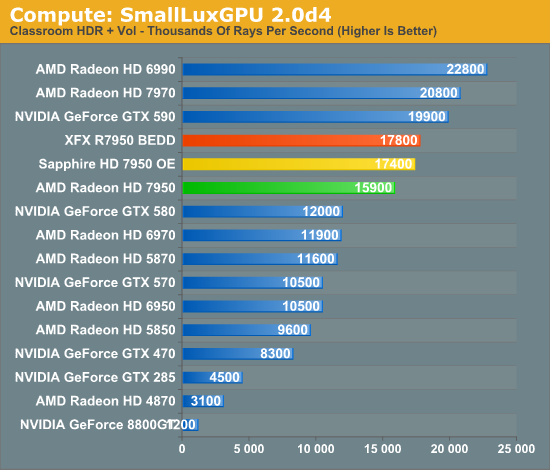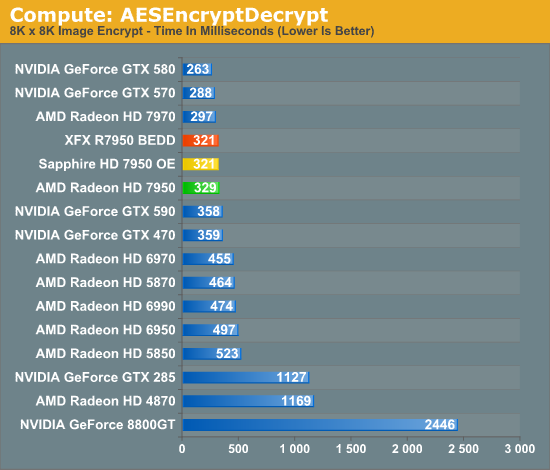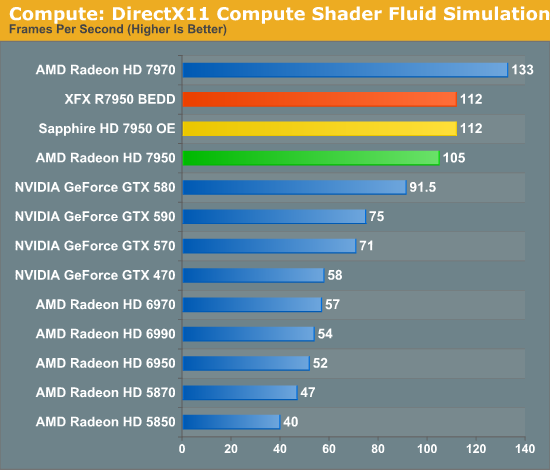AMD Radeon HD 7950 Review Feat. Sapphire & XFX: Sewing Up The High-End Market
by Ryan Smith on January 31, 2012 9:02 AM ESTCompute Performance
Moving on from our look at gaming performance, we have our customary look at compute performance. Since compute performance is by definition shader bound, the 7950 is at a bit of a disadvantage here compared to gaming performance. Whereas ROP performance scales with the core clock, shader performance is hit by both the reduction in the core clock and the disabled CU array.
Our first compute benchmark comes from Civilization V, which uses DirectCompute to decompress textures on the fly. Civ V includes a sub-benchmark that exclusively tests the speed of their texture decompression algorithm by repeatedly decompressing the textures required for one of the game’s leader scenes. Note that this is a DX11 DirectCompute benchmark.

AMD’s greatly improved compute performance continues to shine here, though in the case of Civilization V it’s largely consumed by just closing the previously large gap between the GTX 500 series and the Radeon HD 6000 series. As a result the 7950 falls ever so short of the GTX 580, while the factory overclocked Sapphire and XFX cards give the 7950 enough of a push to come within 5% of the 7970.
Our next benchmark is SmallLuxGPU, the GPU ray tracing branch of the open source LuxRender renderer. We’re now using a development build from the version 2.0 branch, and we’ve moved on to a more complex scene that hopefully will provide a greater challenge to our GPUs.

Under SmallLuxGPU the 7970 enjoyed a large lead over the GTX 580, and this continues with the 7950. Even though the 7950 is well behind the 7970—to the tune of 24%—it’s still 33% ahead of the GTX 580 and the lead only grows from there. Meanwhile the XFX and Sapphire cards can catch up to the 7970 somewhat, but as this is truly a shader-bound test, you can’t make up for the lack of shaders units on the 7950.
For our next benchmark we’re looking at AESEncryptDecrypt, an OpenCL AES encryption routine that AES encrypts/decrypts an 8K x 8K pixel square image file. The results of this benchmark are the average time to encrypt the image over a number of iterations of the AES cypher.

In spite of being a compute benchmark, AESEncryptDecrypt is not particularly sensitive to GPU performance, showcasing the impact that setup times can have. The 7950 trails the 7970 by 10%, and overclocking doesn’t change this much. Unfortunately for AMD NVIDIA is still the leader here, showing that AMD’s compute performance still has room to grow.
Finally, our last benchmark is once again looking at compute shader performance, this time through the Fluid simulation sample in the DirectX SDK. This program simulates the motion and interactions of a 16k particle fluid using a compute shader, with a choice of several different algorithms. In this case we’re using an (O)n^2 nearest neighbor method that is optimized by using shared memory to cache data.

With the compute shader fluid simulation we once again shift back into a compute task that’s much more shader-bound. The 7950 only reaches 80% of the performance of the 7970, once more proving the real impact of losing a CU array. This is still enough to handily surpass the GTX 580 however, with the 7950 taking a 15% lead.










259 Comments
View All Comments
chizow - Thursday, February 2, 2012 - link
No the prices haven't dropped because there's no need to when the 7950 is about the same performance for the same price.As for basic economics, again, you're wrong.
Prices do fall without competition, look at the CPU industry. AMD STILL doesn't have a CPU that competes with the CPUs Intel was putting out 3 years ago.
Yet prices continue to fall, Intel continues to produce faster CPUs.
Why? Because Intel is competing with itself and its consumers need incentive to buy a new CPU. People will not pay the same price for the same speed processor, they demand innovation, progress. They also won't pay significantly more for marginal increases.
They expect more performance at the same prices, which is the same expectation as in the GPU market. Unless you're AMD and their fans I guess.
chizow - Thursday, February 2, 2012 - link
I didn't say anything about the 7970's stock levels, because unlike the 7950, it did actually sell out the 1st day. But there is actually a reason for someone to upgrade to it.The 7950? Not so much, not at that price anyways. If anyone wanted that performance it was there 14 months ago for the same price.
But yeah if you want to compare to past launches, you never saw stock of 5850/5870, 470/480, 570/580 for more than a few minutes at Newegg. Why? Because the performance was there for the asking price.
With these Tahiti cards at the prices and performance, its just lukewarm reception.
chizow - Thursday, February 2, 2012 - link
Nice try deflecting. Please retract your stupid statement about "price always reflecting performance", thanks. RV770 was obviously a price mistake that AMD has clearly tried to correct over the last 3-4 generations since evident by their ever-increasing prices. Either way, you're wrong.Not to mention the 3870 wasn't even the same generation. But yes that card wasn't high end because of its lackluster performance and the fact it was late. It was a refresh of the 2900 and was up against the 8800GT, another refresh part. Regardless, it was still AMD's highest performance single-ASIC SKU, so if it wasn't high-end that just means AMD had nothing worthy of high-end that generation.
Same may happen this round if this is all SI has to offer on 28nm. :(
chizow - Thursday, February 2, 2012 - link
Sure it is, because in this price range, the only people who would be interested in buying it are the people looking to upgrade who have already spent this amount.Sure there's going to be a few first time buyers who may pick this card up and it makes some sense, but this card isn't going to be a worthwhile upgrade for the vast majority of buyers who already have something from the last few generations.
They expect more, simply put.
chizow - Thursday, February 2, 2012 - link
Sure they can, its called projecting or forecasting. It would be negligent of them to ignore what Nvidia has to offer, and similar for Nvidia. Given they share the same fab its obvious neither have a technology advantage, so you have to target your competitor's product using that same technology. Anything less would be irresponsible.chizow - Thursday, February 2, 2012 - link
Rarson, maybe we need to take a step back. You keep insisting I don't understand how this market works, or how pricing is supposed to work. Maybe you can explain how YOU think it works.Let's start off with the basics:
What do you think drives price in the GPU market?
What do you think dictates a particular price:performance metric?
Do you think these two variables continue to scale linearly to infinity as one or the other increases?
What do you think resets this price:performance metric, if at all?
If you can start by answering these questions, and then go back and try to reconcile historical price:performance data points going back to say, the 8800GTX that'd be great.
Thanks!
chizow - Thursday, February 2, 2012 - link
Translation: "I have really low expectations when it comes to GPUs on a new process/technology/architecture"So Sick - Friday, February 3, 2012 - link
CHizzo you talk about a pricing error from AMD but you know what was a the absolute least flattering act in history of the gpu?
When AMD released their Radeon 9700 pro the 5800 ultra from nv stumbled caused by an error making it incapable of running aa correctly...after that the ultimate chaos ever shown in history of hardware was spread by your beloved green hope crew. They had a communication crisis resulting in 3 different versions of their nv40 on different departments without knowing this from each other...in other words the cooperation with their own green colleagues died for a moment and time stood still. Ever since that shameful fact Nvidia is passing AMD..A lot of time they only clzaim they will be fatser in the future like they do now...thank you nv for the green hope in these dark times.....
chizzo take your shizzle talk and stop making a fool of urself please
So Sick - Friday, February 3, 2012 - link
http://nl.hardware.info/reviews/2528/22/amd-radeon...in the vid you see how 3d11 has these results:
7950oc P11392
580oc: P7500? at most...
Boushh - Friday, February 3, 2012 - link
I don't mean to rain on your parade.But when a new product is released, the most obviouse thing to do is to price it at the same level as the highest product from the competitor. Thus AMD should have priced the 7970 around the same amount as the 580.
By doing this you put the pressure on the competitor. You also make sure people choose your product because it is the same price as that of the competitor, but faster, beter, etc.
It's the same what happend just before the release of the Core architecture by Intel. AMD knew that the Core CPU's where much faster, and didn't have anything to compete. Instead of cutting the prices early and gain market share, they waited untill after the last posiible moment to lower their prices.
Sure, the made a dollar or 2, but at what price ?
Once you have the advantage on your competitor, you should use it anyway possible to harm your competitor.
And AMD has the advantage, but they fail to make any use of it at the moment.
Which gives the impresion they don't care about there market share, or if Nvidia would be forced to lower the prices of their products before they wanted to, or if Nvidia will be forced to release there products before they are ready.
But obviously you don't care about that..